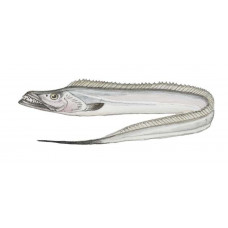Latin name
Trichiuridae
Other names
Сutlass fish, ribbonfish, Atlantic cutlassfish, Pacific cutlassfish, largehead hairtail; Japanese: tachinouo, tachiuo, tachuo; Portuguese: lírio, peixeespada; Spanish: espada, pez sable, sable, savola.
Identification
Characterized by a long, compressed body tapering toward the pointed tail, they are also commonly known as lenticular fish. Their head is lance-shaped, and they have sharp, arrow-like teeth in their large mouths. Their coloration is silvery, and their jaws are rimmed with black.
Distribution
The Atlantic cuttlefish in North America lives from Massachusetts to Argentina and throughout the Gulf of Mexico, especially in Texas. In the Pacific Ocean, the cuttlefish inhabits waters from Southern California to northern Peru.
Habitat
Preferring muddy bottoms in shallow water, cutlassfish gather in large numbers in bays, estuaries, and shallow coastal areas.
Size
Cutlassfish can reach up to 5 feet in length and 2 pounds in weight. The average length is 3 feet. The alltackle record for Atlantic cutlassfish (Trichiurus lepturus) is a 7-pound fish caught in South Africa in 1995.
Life history and Behavior
Juveniles are found in central, coastal Texas in May and June, indicating spawning as early as February. Juveniles are found in deeper waters than adults. In the Sea of Japan, they become sexually mature at age 2 (pre-anal length, about 1 foot). The oldest recorded age is 15 years, although they usually live only 7 or 8 years.
Food and feeding habits
Cuttlefish feed on anchovies, sardines, squid, and crustaceans. Adults usually feed on pelagic prey near the surface during the day and migrate to the bottom at night. Small juveniles do the opposite.
Reproduction
Females produce approximately 3,400 eggs per spawning session (130,000 during the entire spawning period). The eggs are pelagic and hatch after 3-6 days.
| Classification | |
| Phylum | Chordata |
| Class | Actinopterygii |
| Family | Trichiuridae |
Cutlassfish
Tags: Cutlassfish


